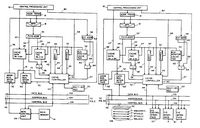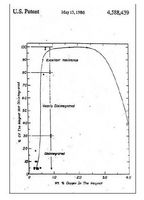QUANTA事件('641システム特許のクレーム1) [米国特許(判例)の研究]
QUANTA COMPUTER, INC. v. LG ELECTRONICS, INCで係争対象となったUSP4,939,641('641システム特許)のクレーム1。個人メモとして。
1. A data processing system including one or more central processing units, main memory means, and bus means, for each central processing unit the invention comprising:
cache memory means coupled between the central processing unit and said bus means;
bus monitor means associated with said cache memory means and coupled to said bus means for detecting on said bus means an address associated with a data unit transferred from said main memory means to a bus connection requesting the data unit;
means coupled to said cache memory means and to said bus means for determining if data having the same address as said transferred data unit is present in said cache memory means and, if present, for asserting a hold signal on said bus means, the assertion of the hold signal indicating at least to the bus connection requesting the data unit that another data unit may be transmitted over said bus means; and
means for detecting whether data corresponding to the address of said transferred data unit and determined to be stored in said cache memory means may be different in content from said transferred data unit and, if so, transmitting said data from said cache memory means to said bus means for reception by the bus connection requesting the data unit.
【メモ】
・CPU、メインメモリ手段、バス手段からなるシステムを規定。(Quantaは、Intelからmicroprocessorsとchipsetsを購入し、システム特許(特に、USP5,077,733 (’733特許))を実施するコンピュータを製造し、販売した。)
・一般論としてコンピュータシステムにおいて、データは通常はメインメモリに記録されるが、アクセス頻度の高いデータは、キャッシュメモリに保存される。キャッシュメモリはメインメモリよりもアクセス速度が早いものであり、通常はmicroprocessor内に配置される。
・データのコピーがキャッシュとメインメモリとに記録されていた場合において、コピーに変更が加えられたとき、他方がオリジナルの古いデータを保持していることある。USP4,939,641('641システム特許)では、データの要求をモニタし、古いデータの要求があったときに、キャッシュメモリの内容でメインメモリの内容を更新することで、最も新しいデータがメインメモリから取得されるシステムの構成を規定している(最高裁の認定)。

椿特許事務所
弁理士TY
1. A data processing system including one or more central processing units, main memory means, and bus means, for each central processing unit the invention comprising:
cache memory means coupled between the central processing unit and said bus means;
bus monitor means associated with said cache memory means and coupled to said bus means for detecting on said bus means an address associated with a data unit transferred from said main memory means to a bus connection requesting the data unit;
means coupled to said cache memory means and to said bus means for determining if data having the same address as said transferred data unit is present in said cache memory means and, if present, for asserting a hold signal on said bus means, the assertion of the hold signal indicating at least to the bus connection requesting the data unit that another data unit may be transmitted over said bus means; and
means for detecting whether data corresponding to the address of said transferred data unit and determined to be stored in said cache memory means may be different in content from said transferred data unit and, if so, transmitting said data from said cache memory means to said bus means for reception by the bus connection requesting the data unit.
【メモ】
・CPU、メインメモリ手段、バス手段からなるシステムを規定。(Quantaは、Intelからmicroprocessorsとchipsetsを購入し、システム特許(特に、USP5,077,733 (’733特許))を実施するコンピュータを製造し、販売した。)
・一般論としてコンピュータシステムにおいて、データは通常はメインメモリに記録されるが、アクセス頻度の高いデータは、キャッシュメモリに保存される。キャッシュメモリはメインメモリよりもアクセス速度が早いものであり、通常はmicroprocessor内に配置される。
・データのコピーがキャッシュとメインメモリとに記録されていた場合において、コピーに変更が加えられたとき、他方がオリジナルの古いデータを保持していることある。USP4,939,641('641システム特許)では、データの要求をモニタし、古いデータの要求があったときに、キャッシュメモリの内容でメインメモリの内容を更新することで、最も新しいデータがメインメモリから取得されるシステムの構成を規定している(最高裁の認定)。
椿特許事務所
弁理士TY
「米国特許判例の最新動向」に参加して [米国特許(判例)の研究]
ワシントン大学ロースクール(University of Washington School of Law)の教授であり、米国弁護士である竹中俊子先生による、「米国特許判例の最新動向」の講義に参加させて頂きました。
講義では、米国法改正、USPTO審査ルールの改正に関する現状、最新の最高裁、CAFCの判例などについて、実務に役立つ情報を教えて頂きました。ありがとうございました。実際に出願、中間実務を行なう上で役に立つ判例などに、特に興味を持ちました。
【個人メモ】
(1)KSR最高裁判決後の実務の影響
・例えばteach away(阻害事由)が認められる条件(In Re Icon Health and Fitness, Inc.)など
“A reference may be said to teach away when a person of ordinary skill, upon reading the reference, would be discouraged from following the path set out in the reference, or would be led in a direction divergent from the path that was taken by the applicant.” In re Gurley, 27 F.3d 551, 553 (Fed. Cir. 1994); see KSR, 127 S. Ct. at 1739–40 (explaining that when the prior art teaches away from a combination, that combination is more likely to be nonobvious). Additionally, a reference may teach away from a use when that use would render the result inoperable. McGinley v. Franklin Sports, Inc., 262 F.3d 1339, 1354 (Fed. Cir. 2001).
http://www.ll.georgetown.edu/federal/judicial/fed/opinions/06opinions/06-1573.pdf
より
(2)Inequitable Conduct(不公正行為)が立証されることによる権利行使のハードル(結構日本の実務では問題とされることも多いのかもしれない。研究要。)
・Monsanto v. Bayer Bioscience ほか
(3)クレーム解釈ルールに関する最近の状況
・Phillips判決以降の判決
・Voda, M.D. v. Cordis Corporationほか(明細書が限定解釈の基礎にならない場合などに言及。研究要。)
・要約書が権利解釈に及ぼす影響
椿特許事務所
弁理士TY
講義では、米国法改正、USPTO審査ルールの改正に関する現状、最新の最高裁、CAFCの判例などについて、実務に役立つ情報を教えて頂きました。ありがとうございました。実際に出願、中間実務を行なう上で役に立つ判例などに、特に興味を持ちました。
【個人メモ】
(1)KSR最高裁判決後の実務の影響
・例えばteach away(阻害事由)が認められる条件(In Re Icon Health and Fitness, Inc.)など
“A reference may be said to teach away when a person of ordinary skill, upon reading the reference, would be discouraged from following the path set out in the reference, or would be led in a direction divergent from the path that was taken by the applicant.” In re Gurley, 27 F.3d 551, 553 (Fed. Cir. 1994); see KSR, 127 S. Ct. at 1739–40 (explaining that when the prior art teaches away from a combination, that combination is more likely to be nonobvious). Additionally, a reference may teach away from a use when that use would render the result inoperable. McGinley v. Franklin Sports, Inc., 262 F.3d 1339, 1354 (Fed. Cir. 2001).
http://www.ll.georgetown.edu/federal/judicial/fed/opinions/06opinions/06-1573.pdf
より
(2)Inequitable Conduct(不公正行為)が立証されることによる権利行使のハードル(結構日本の実務では問題とされることも多いのかもしれない。研究要。)
・Monsanto v. Bayer Bioscience ほか
(3)クレーム解釈ルールに関する最近の状況
・Phillips判決以降の判決
・Voda, M.D. v. Cordis Corporationほか(明細書が限定解釈の基礎にならない場合などに言及。研究要。)
・要約書が権利解釈に及ぼす影響
椿特許事務所
弁理士TY
meansクレーム使用時の明細書の記載要件 [米国特許(判例)の研究]
【個人メモとして】
meansクレームを起草したとき、その構成要素に関しては、米国特許法112条第6パラグラフにいう「対応の構造(structure)」がその明細書に開示されている必要がある。米国においてその判断は他の国よりも厳しく、米国以外の実務に則った外国明細書(例えば日本出願明細書)を翻訳しただけでは(あるいは米国以外の実務に則った明細書でPCT出願を行なっただけでは)、米国において出願が拒絶されたり、無効となることがある。
例えば、
ARISTOCRAT TECHNOLOGIES AUSTRALIA PTY LIMITED and ARISTOCRAT TECHNOLOGIES, INC., v. INTERNATIONAL GAME TECHNOLOGY and IGT
http://caselaw.lp.findlaw.com/data2/circs/fed/071419p.pdf
(オーストラリアでなされたPCT出願のmeansクレーム記載要件が、米国法に則っていないとして特許が無効とされたケース)
BIOMEDINO, LLC, v. WATERS TECHNOLOGIES CORPORATION et al.
http://www.ll.georgetown.edu/federal/judicial/fed/opinions/06opinions/06-1350.pdf
("control means"に対応する構成物が明細書に開示されていたかが争点となり、技術常識の参酌からその開示を補うことが否定されたケース)
一方、
IN RE OLAF H. DOSSEL and WALTER H. KULLMANN
http://www.ll.georgetown.edu/federal/judicial/fed/opinions/96opinions/96-1340.pdf
(ドイツ出願を基礎としてなされた米国出願における、meansクレームの対応物が明細書に記載されているかが争われ、結果を生じさせる数学的アルゴリズムまで明細書に記載されていなくても、コンピュータを用いる手法などの従来技術からそれは自明であるとされたケース)
例えば、コンピュータ発明においては、meansに対応するコンピュータプログラムのソースコードの記載までは要求されないが、記載不備を避けるためには詳細なアルゴリズムを記載しなければならないとされる。一方で、詳細に記載しすぎると、meansクレームの権利範囲が極めて狭くなるという二律背反が生じる。
それでは、どの程度の感覚でmeansクレームや明細書を作成すべきか。アメリカ出願を考えたとき、どのような日本出願明細書を作成しておくべきか。
また、他の好ましい策はないか?(例えば方法クレームの作成など)
椿特許事務所
弁理士TY
meansクレームを起草したとき、その構成要素に関しては、米国特許法112条第6パラグラフにいう「対応の構造(structure)」がその明細書に開示されている必要がある。米国においてその判断は他の国よりも厳しく、米国以外の実務に則った外国明細書(例えば日本出願明細書)を翻訳しただけでは(あるいは米国以外の実務に則った明細書でPCT出願を行なっただけでは)、米国において出願が拒絶されたり、無効となることがある。
例えば、
ARISTOCRAT TECHNOLOGIES AUSTRALIA PTY LIMITED and ARISTOCRAT TECHNOLOGIES, INC., v. INTERNATIONAL GAME TECHNOLOGY and IGT
http://caselaw.lp.findlaw.com/data2/circs/fed/071419p.pdf
(オーストラリアでなされたPCT出願のmeansクレーム記載要件が、米国法に則っていないとして特許が無効とされたケース)
BIOMEDINO, LLC, v. WATERS TECHNOLOGIES CORPORATION et al.
http://www.ll.georgetown.edu/federal/judicial/fed/opinions/06opinions/06-1350.pdf
("control means"に対応する構成物が明細書に開示されていたかが争点となり、技術常識の参酌からその開示を補うことが否定されたケース)
一方、
IN RE OLAF H. DOSSEL and WALTER H. KULLMANN
http://www.ll.georgetown.edu/federal/judicial/fed/opinions/96opinions/96-1340.pdf
(ドイツ出願を基礎としてなされた米国出願における、meansクレームの対応物が明細書に記載されているかが争われ、結果を生じさせる数学的アルゴリズムまで明細書に記載されていなくても、コンピュータを用いる手法などの従来技術からそれは自明であるとされたケース)
例えば、コンピュータ発明においては、meansに対応するコンピュータプログラムのソースコードの記載までは要求されないが、記載不備を避けるためには詳細なアルゴリズムを記載しなければならないとされる。一方で、詳細に記載しすぎると、meansクレームの権利範囲が極めて狭くなるという二律背反が生じる。
それでは、どの程度の感覚でmeansクレームや明細書を作成すべきか。アメリカ出願を考えたとき、どのような日本出願明細書を作成しておくべきか。
また、他の好ましい策はないか?(例えば方法クレームの作成など)
椿特許事務所
弁理士TY
Johnson & Johnston Assocs. v. R.E. Service (7) [米国特許(判例)の研究]
In YBM Magnex , the patent claimed a permanent magnet alloy comprising certain elements, including “6,000 to 35,000 ppm oxygen.” U.S. Patent No. 4,588,439 (the ’439 patent), col. 3, l. 12. The accused infringer used similar magnet alloys with an oxygen content between 5,450 and 6,000 ppm (parts per million), which was allegedly disclosed but not claimed in the ’439 patent. In YBM Magnex , this court stated that Maxwell did not create a new rule of law that doctrine of equivalents could never encompass subject matter disclosed in the specification but not claimed. 145 F.3d at 1321.
Distinguishing Maxwell, this court noted:
Maxwell avoided examination of the unclaimed alternative, which was distinct from the claimed alternative. In view of the distinctness of the two embodiments, both of which were fully described in the specification, the Federal Circuit denied Maxwell the opportunity to enforce the unclaimed embodiment as an equivalent of the one that was claimed. Id. at 1320.
In other words, this court in YBM Magnex purported to limit Maxwell to situations where a patent discloses an unclaimed alternative distinct from the claimed invention. Thus, this court must decide whether a patentee can apply the doctrine of equivalents to cover unclaimed subject matter disclosed in the specification.
(つづく)
【メモ】
・YBM社のU.S. Patent No. 4,588,439 のクレーム1は、以下の通り。
1. A permanent magnet alloy consisting essentially of, in weight percent, 30 to 36 of at least one rare earth element, 60 to 66 iron, 6,000 to 35,000 ppm oxygen and balance boron.
・特許における酸素の含有量が、6,000~35,000ppmであるのに対して、イ号における酸素の含有量は、5,450~6,000ppmの範囲だった。ちなみに、特許明細書には下記の図1が記載されており、6,000~35,000ppmというのは、「Excellent Resistance」の範囲に該当するグラフ横軸の範囲である。

Maxwell以降に生じたYBM事件において、裁判所は、「Maxwellは、明細書に記載されクレームされていない部分を均等論がカバーできない、というDOEの新しいルールを作ったものと解釈すべきではない」と判示。Maxwellは、2つの明確に異なる実施例のうち、その1つのみをクレームした事例であった、というのがその理由。
【その他】
Merry Merry Christmas!
椿特許事務所
弁理士TY
Distinguishing Maxwell, this court noted:
Maxwell avoided examination of the unclaimed alternative, which was distinct from the claimed alternative. In view of the distinctness of the two embodiments, both of which were fully described in the specification, the Federal Circuit denied Maxwell the opportunity to enforce the unclaimed embodiment as an equivalent of the one that was claimed. Id. at 1320.
In other words, this court in YBM Magnex purported to limit Maxwell to situations where a patent discloses an unclaimed alternative distinct from the claimed invention. Thus, this court must decide whether a patentee can apply the doctrine of equivalents to cover unclaimed subject matter disclosed in the specification.
(つづく)
【メモ】
・YBM社のU.S. Patent No. 4,588,439 のクレーム1は、以下の通り。
1. A permanent magnet alloy consisting essentially of, in weight percent, 30 to 36 of at least one rare earth element, 60 to 66 iron, 6,000 to 35,000 ppm oxygen and balance boron.
・特許における酸素の含有量が、6,000~35,000ppmであるのに対して、イ号における酸素の含有量は、5,450~6,000ppmの範囲だった。ちなみに、特許明細書には下記の図1が記載されており、6,000~35,000ppmというのは、「Excellent Resistance」の範囲に該当するグラフ横軸の範囲である。
Maxwell以降に生じたYBM事件において、裁判所は、「Maxwellは、明細書に記載されクレームされていない部分を均等論がカバーできない、というDOEの新しいルールを作ったものと解釈すべきではない」と判示。Maxwellは、2つの明確に異なる実施例のうち、その1つのみをクレームした事例であった、というのがその理由。
【その他】
Merry Merry Christmas!
椿特許事務所
弁理士TY
Johnson & Johnston Assocs. v. R.E. Service (6) [米国特許(判例)の研究]
In Maxwell, the patent claimed a system for attaching together a mated pair of shoes. 86 F.3d at 1101-02. Maxwell claimed fastening tabs between the inner and outer soles of the attached shoes. Maxwell disclosed in the specification, but did not claim, fastening tabs that could be “stitched into a lining seam of the shoes.” U.S. Patent No. 4,624,060, col. 2, l. 42. Based on the “well-established rule that ‘subject matter disclosed but not claimed in a patent application is dedicated to the public,’” this court held that Baker could not, as a matter of law, infringe under the doctrine of equivalents by using the disclosed but unclaimed shoe attachment system.
Maxwell, 86 F.3d at 1106 (quoting Unique Concepts, Inc. v. Brown, 939 F.2d 1558, 1562-63, 19 USPQ2d 1500, 1504 (Fed. Cir. 1991)).
This court stated further:
By [Maxwell’s failure] to claim these alternatives, the Patent and Trademark Office was deprived of the opportunity to consider whether these alternatives were patentable. A person of ordinary skill in the shoe industry, reading the specification and prosecution history, and interpreting the claims, would conclude that Maxwell, by failing to claim the alternate shoe attachment systems in which the tabs were attached to the inside shoe lining, dedicated the use of such systems to the public. Maxwell, 86 F.3d at 1108.
(つづく)
【メモ】
Maxwellさんのクレームでは、
"each of said shoes further having a fastening tab [12] and means for securing said tab between said inner and outer soles"と規定。
明細書には、
...."Alternatively, the tabs may be stitched into a lining seam of the shoes at the sides or back of the shoes."
と記載。
ちなみに、
lining:裏地
seam:縫い目、繋ぎ目
やはりこのシチュエーションであれば、法律問題として、権利が"between said inner and outer soles"のものに限定されても仕方ないように思う。
・meansクレームなので、"between said inner and outer soles"がなければ、"stitched into a lining seam"の侵害形態(およびその均等物)もカバー可能であった。この辺り、meansクレームの特性を十全に理解する必要がある(日本実務家の中にはmeansクレームを極端に嫌う人が多く、「means」の使用はやめてくれ、というクライアント企業も多いと思うが)。この点に関し、1952年の米国特許法改正(112条第6パラグラフ導入時)の趣旨も参照のこと。
・実際、USアトーニー(またはエージェント)作成の明細書や、判例などを見ると、meansクレームの使い方に関しては参考とすべきケースが多々ある。(結果的に、使って失敗例だったケースも勿論あるが。)
【その他】
Merry Christmas!
椿特許事務所
弁理士TY
Maxwell, 86 F.3d at 1106 (quoting Unique Concepts, Inc. v. Brown, 939 F.2d 1558, 1562-63, 19 USPQ2d 1500, 1504 (Fed. Cir. 1991)).
This court stated further:
By [Maxwell’s failure] to claim these alternatives, the Patent and Trademark Office was deprived of the opportunity to consider whether these alternatives were patentable. A person of ordinary skill in the shoe industry, reading the specification and prosecution history, and interpreting the claims, would conclude that Maxwell, by failing to claim the alternate shoe attachment systems in which the tabs were attached to the inside shoe lining, dedicated the use of such systems to the public. Maxwell, 86 F.3d at 1108.
(つづく)
【メモ】
Maxwellさんのクレームでは、
"each of said shoes further having a fastening tab [12] and means for securing said tab between said inner and outer soles"と規定。
明細書には、
...."Alternatively, the tabs may be stitched into a lining seam of the shoes at the sides or back of the shoes."
と記載。
ちなみに、
lining:裏地
seam:縫い目、繋ぎ目
やはりこのシチュエーションであれば、法律問題として、権利が"between said inner and outer soles"のものに限定されても仕方ないように思う。
・meansクレームなので、"between said inner and outer soles"がなければ、"stitched into a lining seam"の侵害形態(およびその均等物)もカバー可能であった。この辺り、meansクレームの特性を十全に理解する必要がある(日本実務家の中にはmeansクレームを極端に嫌う人が多く、「means」の使用はやめてくれ、というクライアント企業も多いと思うが)。この点に関し、1952年の米国特許法改正(112条第6パラグラフ導入時)の趣旨も参照のこと。
・実際、USアトーニー(またはエージェント)作成の明細書や、判例などを見ると、meansクレームの使い方に関しては参考とすべきケースが多々ある。(結果的に、使って失敗例だったケースも勿論あるが。)
【その他】
Merry Christmas!
椿特許事務所
弁理士TY



